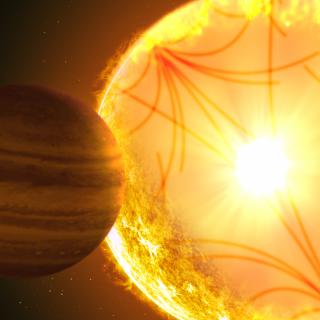Bibcode
Baran, A.; Oreiro, R.; Pigulski, A.; Pérez Hernández, F.; Ulla, A.; Reed, M. D.; Rodríguez-López, C.; Moskalik, P.; Kim, S.-L.; Chen, W.-P.; Crowe, R.; Siwak, M.; Armendarez, L.; Binder, P. M.; Choo, K.-J.; Dye, A.; Eggen, J. R.; Garrido, R.; González Pérez, J. M.; Harms, S. L.; Huang, F.-Y.; Kozieł, D.; Lee, H.-T.; MacDonald, J.; Fox Machado, L.; Monserrat, T.; Stevick, J.; Stewart, S.; Terry, D.; Zhou, A.-Y.; Zoła, S.
Bibliographical reference
Monthly Notices of the Royal Astronomical Society, Volume 392, Issue 3, pp. 1092-1105.
Advertised on:
1
2009
Citations
43
Refereed citations
37
Description
We present the results of a multisite photometric campaign on the
pulsating B-type hot subdwarf star Balloon090100001 (Bal09). The star is
one of the two known hybrid hot subdwarfs with both long- and
short-period oscillations, theoretically attributed to g and p modes.
The campaign involved eight telescopes with three obtaining UBVR data,
four B-band data and one Strömgren uvby photometry. The campaign
covered 48 nights, providing a temporal resolution of 0.36μHz with a
detection threshold of about 0.2mmag in B-filter data.
Bal09 has the richest pulsation spectrum of any known pulsating subdwarf
B star, and our analysis detected 114 frequencies including 97
independent and 17 combination ones. Most of the 24 g-mode frequencies
are between 0.1 and 0.4mHz. Of the remaining 73, presumably p modes, 72
group into four distinct regions near 2.8, 3.8, 4.7 and 5.5mHz. The
density of frequencies requires that some modes must have degrees l
larger than 2. The modes in the 2.8 mHz region have the largest
amplitudes. The strongest mode (f1) is most likely radial,
while the remaining ones in this region form two nearly symmetric
multiplets: a triplet and quintuplet, attributed to rotationally split l
= 1 and 2 modes, respectively. We find clear increases of splitting in
both multiplets between the 2004 and 2005 observing campaigns, amounting
to ~15 per cent on average. The observed splittings imply that the
rotational rate in Bal09 depends on stellar latitude and is the fastest
on the equator. We also speculate on the possible reasons for the
changes of splitting. The only plausible explanation we find is
torsional oscillation. This hypothesis, however, needs to be verified in
the future by detailed modelling. In this context, it is very important
to monitor the splittings on a longer time-scale as their behaviour may
help to explain this interesting phenomenon.
The amplitudes of almost all terms detected in both 2004 and 2005 were
found to vary. This is evident even during one season; for example,
amplitudes of modes f8 and fC were found to change
by a factor of 2-3 within about 50 d during 2005.
We use a small grid of models to constrain the main mode
(f1), which most likely represents the radial fundamental
pulsation. The groups of p-mode frequencies appear to lie in the
vicinity of the consecutive radial overtones, up to the third one.
Despite the large number of g-mode frequencies observed, we failed to
identify them, most likely because of the disruption of asymptotic
behaviour by mode trapping. The observed frequencies were not, however,
fully exploited in terms of seismic analysis which should be done in the
future with a larger grid of reliable evolutionary models of hot
subdwarfs.
Related projects

Helio and Astero-Seismology and Exoplanets Search
The principal objectives of this project are: 1) to study the structure and dynamics of the solar interior, 2) to extend this study to other stars, 3) to search for extrasolar planets using photometric methods (primarily by transits of their host stars) and their characterization (using radial velocity information) and 4) the study of the planetary
Savita
Mathur